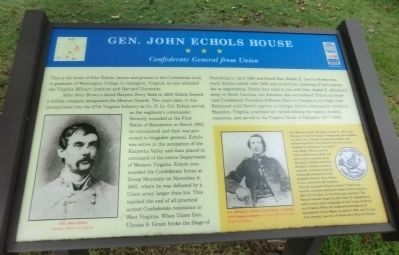Union in Monroe County, West Virginia — The American South (Appalachia)
Gen. John Echols House
Confederate General from Union
After John Brown’s failed Harpers Ferry Raid in 1859, Echols formed a militia company designated the Monroe Guards. Two years later, it was incorporated into the 27th Virginia Infantry as Co. D. Lt. Col. Echols served as the regiment’s commander. Severely wounded at the First Battle of Kernstown in March 1862 he convalesced and then was promoted to brigadier general. Echols was active in the occupation of the Kanawha Valley and then placed in command of the entire Department of Western Virginia. Echols commanded the Confederate forces at Droop Mountain on November 6, 1863, where he was defeated by a Union army larger than his. This marked the end of all practical armed Confederate resistance in West Virginia. When Union Gen. Ulysses S. Grant broke the Siege of Petersburg in April 1865 and forced Gen. Robert E. Lee to retreat westward, Echols rushed with 7,000 men to join Lee. Learning of Lee’s surrender at Appomattox, Echols then tried to join with Gen. Joseph E. Johnston’s army in North Carolina, but Johnston also surrendered. Echols accompanied Confederate President Jefferson Davis to Georgia in his flight from Richmond until Davis’s capture in Georgia. Echols subsequently settled in Staunton, Virginia, practiced law, helped develop the region’s mineral resources, and served in the Virginia House of Delegates (1877-1880).
(Sidebar): The Monroe Guards left Union on May 13, 1861, with 108 men. At the First Battle of Manassas the regiment served in Gen. Thomas J. Jackson's brigade and suffered heavily in the defensive line that earned Jackson the nickname "Stonewall." Capt. Hugh Tiffany and five other Guards were killed, and eleven were wounded. After the battle, Jackson chose Pvt. Michael A. Foster to receive a wreath of flowers from the women of Lexington for the brigade's bravery. Gen. Robert E. Lee called him the brigade's "bravest and most efficient soldier." Foster was severely wounded during the Siege of Petersburg in 1864, left for dead on the field, and captured. The Monroe Guards fought in more than 70 engagements in every major campaign of Lee's Army of Northern Virginia. When the regiment surrendered at Appomattox Court House on April 9, 1865, only 21 men were present, just two of whom were Monroe Guards.
Erected by West Virginia Civil War Trails.
Topics and series. This historical marker is listed in this topic list: War, US Civil. In addition, it is included in the West Virginia Civil War Trails series list. A significant historical month for this entry is March 1862.
Location. 37° 35.55′ N, 80° 32.532′ W. Marker is in Union, West Virginia, in Monroe County. Marker is at the intersection of 2nd Street and Pump Street, on the right when traveling west on 2nd Street. Touch for map. Marker is in this post office area: Union WV 24983, United States of America. Touch for directions.
Other nearby markers. At least 8 other markers are within walking distance of this marker. Bishop Matthew W. Clair, Sr. (about 300 feet away, measured in a direct line); Union (about 600 feet away); Crook's Occupation of Union (about 600 feet away); General John Echols (about 600 feet away); William Porcher Miles (about 600 feet away); Union Presbyterian Church (approx. 0.2 miles away); Allen T. Caperton (approx. 0.2 miles away); Civil War Monument (approx. 0.2 miles away). Touch for a list and map of all markers in Union.
Credits. This page was last revised on June 16, 2016. It was originally submitted on September 7, 2012, by Don Morfe of Baltimore, Maryland. This page has been viewed 922 times since then and 39 times this year. Photos: 1, 2. submitted on September 7, 2012, by Don Morfe of Baltimore, Maryland. • Craig Swain was the editor who published this page.

